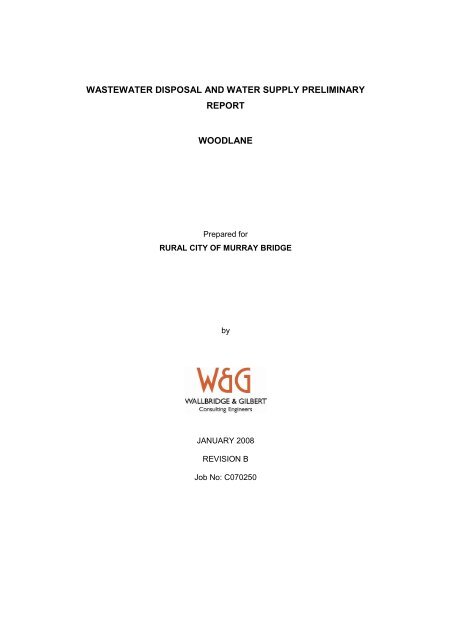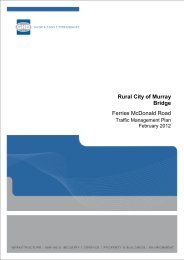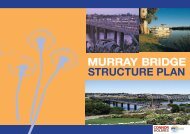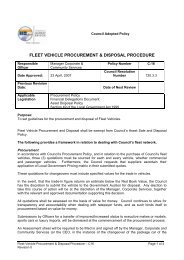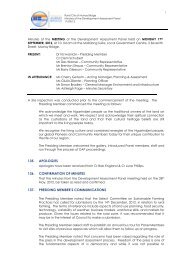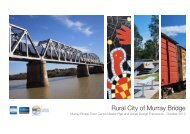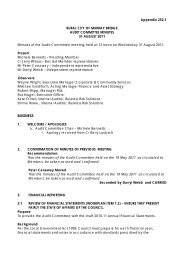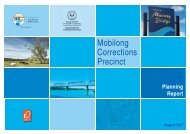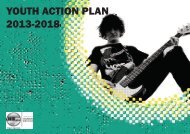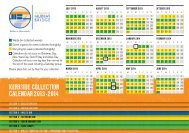wastewater disposal and water supply preliminary report woodlane
wastewater disposal and water supply preliminary report woodlane
wastewater disposal and water supply preliminary report woodlane
Create successful ePaper yourself
Turn your PDF publications into a flip-book with our unique Google optimized e-Paper software.
WASTEWATER DISPOSAL AND WATER SUPPLY PRELIMINARY<br />
REPORT<br />
WOODLANE<br />
Prepared for<br />
RURAL CITY OF MURRAY BRIDGE<br />
by<br />
JANUARY 2008<br />
REVISION B<br />
Job No: C070250
CONTENTS<br />
1. PROJECT APPRECIATION<br />
1.1 INTRODUCTION<br />
1.2 BACKGROUND INVESTIGATION<br />
1.2.1 DOCUMENTATION REVIEW<br />
1.2.2 INVESTIGATION AND EXPLORATION<br />
1.2.3 INTERPRETATION OF FINDINGS<br />
2. SEWAGE DISPOSAL SCHEME<br />
2.1 SEWERAGE SCHEME<br />
2.1.1 ASSETS REGISTER<br />
2.1.2 CAPACITY ASSESSMENT<br />
2.2 EFFLUENT TREATMENT AND REUSE<br />
2.2.1 WASTEWATER TREATMENT PLANT<br />
2.2.2 IRRIGATION<br />
3. WATER SUPPLY SYSTEM<br />
3.1 GENERAL<br />
3.2 WATER TREATMENT PLANT<br />
3.3 ALTERNATIVE FUTURE WATER SUPPLY<br />
4. ISSUES AND RECOMENDATIONS<br />
4.1 SEWAGE SYSTEM<br />
4.2 WATER SUPPLY<br />
4.3 OPERATION AND MAINTENANCE<br />
Woodlane Waste<strong>water</strong> Disposal <strong>and</strong> Water Supply Preliminary Report<br />
Wallbridge & Gilbert/070250rp002RevB/January 2008 Page 1
CONTENTS (continued)<br />
5. APPENDICES<br />
APPENDIX A – Secon Consulting Engineers Drawings List<br />
APPENDIX B – Aeroflo WWTP Layout<br />
APPENDIX C – Sewer Pump Curves<br />
Data Sheets <strong>and</strong> Performance Curves<br />
APPENDIX D – Sewer Assets Register<br />
APPENDIX E – Sewage Capacity Assessment<br />
APPENDIX F – DAC Approvals<br />
APPENDIX G – DH Approval December 1998<br />
APPENDIX H – DH Approval 21 August 1996<br />
APPENDIX I – DH Approval 17 December 1996<br />
APPENDIX J – GHD Water Treatment Plant Assessment<br />
APPENDIX K – Abtech WTP Specifications<br />
APPENDIX L – Abtech WTP Maintenance Schedule<br />
APPENDIX M – Abtech Plant Log Sheet<br />
APPENDIX N – SA Water Chemical Dosage Records<br />
APPENDIX O – SA Water Main Layout<br />
APPENDIX P – Photographs<br />
Woodlane Waste<strong>water</strong> Disposal <strong>and</strong> Water Supply Preliminary Report<br />
Wallbridge & Gilbert/070250rp002RevB/January 2008 Page 2
CONTENTS (continued)<br />
6. REFERENCES<br />
1. Secon Consulting Engineers Submitted Report 3,<br />
Woodlane <strong>and</strong> Mypolonga Shacks, Document No.<br />
91632 REP Rev 2, 29 July 1997.<br />
2. Norman Waterhouse Effluent Scheme Draft Agreement<br />
between Council <strong>and</strong> Secon Consulting Engineers, ref:<br />
227041/SDK0029, 24 December1999.<br />
3. United Water Woodlane STEDS Audit Report, April<br />
2006.<br />
4. Abtech Water Treatment Plant Specifications,<br />
Installation, Operation, Maintenance <strong>and</strong> Material<br />
Technical Data Booklet, 12 October 1998.<br />
5. SA Water Draft Agreement No 544.<br />
6. Australian Water Quality Centre Final Analytical Report<br />
issued to DIPA Consulting, Customer Service Request<br />
No. 140836-2007-CSR-1, Sample Date Range 11 Oct<br />
07 – 24 Oct 07.<br />
7. Department of Water, L<strong>and</strong> <strong>and</strong> Biodiversity<br />
Conservation Water Licence Nos. 943 & 2740<br />
Woodlane Waste<strong>water</strong> Disposal <strong>and</strong> Water Supply Preliminary Report<br />
Wallbridge & Gilbert/070250rp002RevB/January 2008 Page 3
1. PROJECT APPRECIATION<br />
1.1 INTRODUCTION<br />
The Woodlane <strong>waste<strong>water</strong></strong> <strong>disposal</strong> <strong>and</strong> <strong>water</strong> <strong>supply</strong> schemes were originally<br />
proposed to be constructed by Mr Desmond Murray <strong>and</strong> Pat Wynne as part of<br />
their residential sub-division development with development act approvals<br />
obtained from The Rural City of Murray Bridge in April 1997. The schemes<br />
were commissioned in 2001. The schemes were then h<strong>and</strong>ed over to The<br />
Rural City of Murray Bridge, serving 40 new residential properties <strong>and</strong> 19 preexisting<br />
shacks. The schemes were developed along the Murray River<br />
immediately above the 1956 flood level. The l<strong>and</strong> was previously utilised as an<br />
orange orchard.<br />
Copies of the Development Act Approvals (development number 415/240/96)<br />
issued by Council are attached in Appendix F for reference.<br />
The consultant engaged to undertake the project was Secon Consulting<br />
Engineers (former Hutt Pike <strong>and</strong> Associates), with Robert C. Frazer <strong>and</strong><br />
Associates Consulting Engineers as the Civil Engineer. Norman Waterhouse<br />
was engaged by Council to be their legal solicitor for this project.<br />
The Woodlane <strong>waste<strong>water</strong></strong> scheme consists of two separate collection<br />
networks. One services the new housing development along North Bokara<br />
Road <strong>and</strong> Woodlane Drive, which comprises a network of gravity drains with a<br />
connection point provided to each property within the scheme limits. There are<br />
no on-site septic tanks within the sub-division <strong>and</strong> all sewage gravitates directly<br />
to a single pump station at a low point in the system along North Bokara Road<br />
in front of Lot 34. It is then pumped through a rising main to a <strong>waste<strong>water</strong></strong><br />
treatment plant approximately 1.3km south of the development at Lot 50<br />
Woodlane Drive Hd Mobilong at about 53m AHD. Treated effluent from the<br />
plant is then disposed of on a nearby woodlot.<br />
The other network services the existing (as at 1997) shacks closer to the river<br />
along Mathews Court with a connection point provided to each shack,<br />
bypassing the existing septic tanks. The effluent gravitates directly to a second<br />
pump station along Mathews Court near Lot 11, from where it is pumped<br />
through a separate rising main to the sub-division pump station.<br />
Woodlane Waste<strong>water</strong> Disposal <strong>and</strong> Water Supply Preliminary Report<br />
Wallbridge & Gilbert/070250rp002RevB/January 2008 Page 4
The <strong>water</strong> <strong>supply</strong> system draws <strong>water</strong> from the Murray River via two Councilowned<br />
screened positive displacement pumps (DAB Jet 100 MX) housed in a<br />
pump shed by the river bank. Raw <strong>water</strong> is then pumped to a <strong>water</strong> treatment<br />
plant located between the shack site <strong>and</strong> the sub-division along North Bokara<br />
Road, after which treated <strong>water</strong> is then reticulated through both the sub-division<br />
<strong>and</strong> the shack site. There are no <strong>water</strong> meters at each residential property <strong>and</strong><br />
shack allotment.<br />
Both the <strong>waste<strong>water</strong></strong> <strong>disposal</strong> <strong>and</strong> <strong>water</strong> <strong>supply</strong> schemes are currently<br />
maintained by Council but due to the lack of associated as-constructed<br />
information, Council has been unable to have a complete appreciation for their<br />
operational requirements.<br />
Wallbridge <strong>and</strong> Gilbert (W&G) was engaged to prepare operational <strong>and</strong><br />
maintenance manuals for both schemes. W&G proposed a 2 stage process to<br />
prepare the manuals, Stage 1 was an investigation into the system to<br />
determine the components of the system <strong>and</strong> their general condition. Stage 2<br />
was to prepare the operation <strong>and</strong> maintenance manuals. W&G have initially<br />
been engaged to complete stage 1 only. This <strong>report</strong> presents the findings of<br />
the stage 1 investigation.<br />
1.2 BACKGROUND INVESTIGATION<br />
1.2.1 Documentation Review<br />
From an initial review conducted of all the documentation provided by Council,<br />
information on the Woodlane <strong>waste<strong>water</strong></strong> <strong>and</strong> <strong>water</strong> schemes in general were<br />
found to be incomplete with several inconsistencies identified during the<br />
<strong>preliminary</strong> site investigations. Council lacks as-constructed drawings for the<br />
scheme, with the majority of their drawings being for tendering <strong>and</strong> design<br />
purposes only.<br />
A list of Secon drawings provided by Council has been attached in Appendix A<br />
for reference. Among the eleven drawings only the Water Services <strong>and</strong> the<br />
Water Treatment Plant layout are as-constructed, with the remaining as tender<br />
<strong>and</strong> design drawings <strong>and</strong> some of which do not conform to observations made<br />
on site.<br />
Woodlane Waste<strong>water</strong> Disposal <strong>and</strong> Water Supply Preliminary Report<br />
Wallbridge & Gilbert/070250rp002RevB/January 2008 Page 5
The key information deficiencies identified were:<br />
Actual layouts <strong>and</strong> as-constructed configurations of the sewer <strong>and</strong><br />
<strong>water</strong> <strong>supply</strong> system.<br />
Capacities of the <strong>waste<strong>water</strong></strong> <strong>and</strong> <strong>water</strong> <strong>supply</strong> system.<br />
Relationship between the Woodlane reserve toilet block <strong>and</strong> the<br />
<strong>waste<strong>water</strong></strong> <strong>and</strong> <strong>water</strong> <strong>supply</strong> system.<br />
Process flow, performance <strong>and</strong> maintenance of the <strong>waste<strong>water</strong></strong> <strong>and</strong><br />
<strong>water</strong> treatment plants.<br />
Approval status from the Department of Health (DH) <strong>and</strong> Environment<br />
Protection Authority (EPA).<br />
A summary of the documents provided by Council is presented below:<br />
1. Secon Consulting Engineers Submitted Report 3: Woodlane <strong>and</strong><br />
Mypolonga Shacks, Document No, 91632 REP Rev 2, 29 July 1997<br />
It is not clear who this <strong>report</strong> was originally addressed to as details of the<br />
recipient were not found anywhere in the <strong>report</strong>. However, judging from its<br />
contents it is apparent that it was compiled to be submitted to the thendeveloper<br />
Des Murray <strong>and</strong> Pat Wynne, with all the proposed design <strong>and</strong><br />
statutory application details attached.<br />
A diagrammatic map (91632SK9) showing the entire <strong>water</strong> <strong>supply</strong> <strong>and</strong><br />
<strong>waste<strong>water</strong></strong> system for the sub-division <strong>and</strong> shacks was attached to the <strong>report</strong>.<br />
This drawing was a concept <strong>and</strong> does not reflect the as-constructed scheme.<br />
In contrast the other diagrammatic key plan (Item 1 in Appendix A) without any<br />
plot date appears to be a reasonable representation of the system as it is<br />
consistent with other information obtained.<br />
Drawing Plan 91632/ST1 (Sewer Treatment Plant Enclosure) does not show<br />
the as-built scenario of the <strong>waste<strong>water</strong></strong> treatment plant.<br />
Section 2 of the <strong>report</strong> states that there is to be only one 22kL <strong>water</strong> storage<br />
tank at the <strong>water</strong> treatment plant, but there are two of them on site. Section 7<br />
describes three Grundfos CR4-60 vertical multistage <strong>water</strong> pumps in the <strong>water</strong><br />
treatment plant, but there are only two.<br />
Woodlane Waste<strong>water</strong> Disposal <strong>and</strong> Water Supply Preliminary Report<br />
Wallbridge & Gilbert/070250rp002RevB/January 2008 Page 6
Section 8 indicates that there was to be auto paging systems incorporated into<br />
both sewer pump stations, but this is not the case, as verified by ITT Flygt<br />
Limited who had installed the pump stations.<br />
Section 9 of the <strong>report</strong> indicated that WPS were initially to be engaged to<br />
undertake the work due to their successful disinfection trials conducted with SA<br />
Water Corporation. However it appears that the works were undertaken <strong>and</strong><br />
commissioned by Abtech Environmental Services Pty Ltd (Abtech). The reason<br />
for this change could not be determined.<br />
An application was lodged with the SA Health Commission for the WWTP,<br />
however the application was based on the outdated drawing 91632/ST1 as<br />
described earlier <strong>and</strong> there is not any response letter from the Commission<br />
attached in the <strong>report</strong>.<br />
The above inconsistencies indicate that there were a number of changes made<br />
to the installation after the compilation of this <strong>report</strong>. It is clear that the Secon<br />
<strong>report</strong> was <strong>preliminary</strong> in nature <strong>and</strong> a number of changes were made <strong>and</strong> not<br />
registered.<br />
2. Health Commission (DH)<br />
The proposed scheme for the installation of the <strong>waste<strong>water</strong></strong> collection <strong>and</strong><br />
treatment system for the Woodlane sub-division <strong>and</strong> Mypolonga shacks was<br />
approved by the Department of Health (DH) (refer Appendix G), however due<br />
to the lack of an EPA license the DH approval is considered invalid, as<br />
bounded by one of its conditions of approval.<br />
The United Water audit <strong>report</strong> identified that the scheme was within the Murray<br />
River Water Protection zone. This means that the threshold for requiring an<br />
EPA license is lowered from 1000EP schemes to 100 EP schemes. This<br />
scheme has an EP greater than 100 <strong>and</strong> therefore if it is in a <strong>water</strong> protection<br />
zone should be licensed by the EPA.<br />
Other DH conditions of approval not met are (refer Appendix G):<br />
- There is a lack of an automatic telemetry notification system for both pump<br />
stations in the event of alarms.<br />
- There is no formal management agreement between the then-developer,<br />
the Mypolonga shacks owners <strong>and</strong> Council for the continued<br />
Woodlane Waste<strong>water</strong> Disposal <strong>and</strong> Water Supply Preliminary Report<br />
Wallbridge & Gilbert/070250rp002RevB/January 2008 Page 7
esponsibilities of each party required to connect to the scheme, the<br />
individual requirements to connect to the scheme, <strong>and</strong> the on-going<br />
operation <strong>and</strong> maintenance of the <strong>waste<strong>water</strong></strong> collection, treatment <strong>and</strong><br />
irrigation scheme. A draft effluent scheme agreement between Council <strong>and</strong><br />
Secon was drawn up by Norman Waterhouse, ref 227041/SDK0006, dated<br />
15 May 1997 but it wasn’t formalised.<br />
- There is a lack of evidence to indicate that Shack Lot 19 as shown on<br />
Drawing 96210/P01 is connected to the scheme by pumping, as required<br />
in the management agreement described above. Interviews with Council<br />
staff has also revealed that only 18 out of a total 19 pre-existing shacks are<br />
connected to both the <strong>waste<strong>water</strong></strong> treatment <strong>and</strong> <strong>water</strong> <strong>supply</strong> schemes.<br />
Nonetheless it is understood that Council is currently in the process of<br />
establishing the connection of Lot 19 to the scheme.<br />
- Non availability of any operation <strong>and</strong> maintenance manuals for the<br />
<strong>waste<strong>water</strong></strong> treatment system <strong>and</strong> the irrigation scheme.<br />
Attached in Appendices H <strong>and</strong> I are the letters of pre-approvals from the South<br />
Australian Health Commission (SAHC) for the development of the <strong>waste<strong>water</strong></strong><br />
treatment <strong>and</strong> <strong>water</strong> <strong>supply</strong> system respectively, both dated 1996.<br />
1.2.2 Investigation <strong>and</strong> Exploration<br />
In addition to meetings <strong>and</strong> interviews with Council staff, W&G explored other<br />
means of obtaining any available updated information outside Council’s<br />
network. This was done to achieve the most accurate <strong>and</strong> reliable database on<br />
which to base the scheme assessment.<br />
The organisations contacted <strong>and</strong> the relevant findings are summarised below:<br />
1. Secon Consulting Engineers (Secon)<br />
Based on the initials printed on the Secon drawings, Mr Ken Hutt was traced<br />
<strong>and</strong> contacted, who had been the project manager <strong>and</strong> main liaison person<br />
representing the developer in the project. At the time of contact he had left<br />
Secon but verified that the available drawings provided by Council are all that<br />
are available. A similar enquiry to Secon directly had drawn the same<br />
conclusion.<br />
Woodlane Waste<strong>water</strong> Disposal <strong>and</strong> Water Supply Preliminary Report<br />
Wallbridge & Gilbert/070250rp002RevB/January 2008 Page 8
Although not critical, it may be worth mentioning that unlike the other drawings,<br />
91632/P06 – Eco Trap on Storm<strong>water</strong> was issued by Hutt Pike <strong>and</strong> Associates<br />
<strong>and</strong> from its much earlier plot date (Oct 1995), it seemed that there had been a<br />
transition from Hutt Pike to Secon during the design phase. This was later<br />
verified by Ken himself.<br />
With regard to the Woodlane reserve toilet block Ken recalled that it was<br />
connected to the sewerage <strong>and</strong> <strong>water</strong> <strong>supply</strong> system only after the h<strong>and</strong>over of<br />
the completed project to Council. This connection is not shown anywhere on<br />
the drawings, although subsequent liaison with SA Water confirms that the<br />
toilet block is connected to a nearby SA Water 100mm main approximately<br />
170m away on North Bokara Road.<br />
2. SA Water<br />
Contact with the SA Water Chemical Dosing Department at Murray Bridge<br />
suggests that the two raw <strong>water</strong> pumps by the river do not belong to SA Water<br />
but to Council, although they do sometimes maintain the pumps when required,<br />
despite the lack of any formal agreement for them to do so. The pumps are<br />
model DAB Jet 100 MX, located within a screened shed together with two other<br />
operating irrigation pumps (Hydro Titan) that irrigate the reserves within the<br />
development. SA Water believes that these irrigation pumps are owned <strong>and</strong><br />
maintained by the local residents.<br />
3. Department of Water, L<strong>and</strong> <strong>and</strong> Biodiversity Conservation (DWLBC)<br />
Feedback from the DWLBC has indicated that Council does possess a <strong>water</strong><br />
licence (Licence no. 2740) taking 20,000kL of <strong>water</strong> per annum for the<br />
Woodlane sub-division for domestic purposes. DWLBC however also indicated<br />
that no <strong>water</strong> licence has been issued for the shacks.<br />
A <strong>water</strong> meter (meter no. 30125494) was also present in the <strong>water</strong> treatment<br />
plant located along the river <strong>water</strong> intake pipe <strong>and</strong> is owned by Council, but<br />
monitored by DWLBC for the river <strong>water</strong> intake amount.<br />
Another <strong>water</strong> licence issued to Council is for the Woodlane public reserves<br />
under licence no. 943 <strong>and</strong> measured off <strong>water</strong> meter no. 12273. The Woodlane<br />
reserves together with several other reserves are allocated a total of 249,560kL<br />
of <strong>water</strong> per annum for recreational purposes from the Murray River.<br />
Woodlane Waste<strong>water</strong> Disposal <strong>and</strong> Water Supply Preliminary Report<br />
Wallbridge & Gilbert/070250rp002RevB/January 2008 Page 9
4. Aquatec-Maxcon Pty Ltd (Aquatec)<br />
Known as Aeroflo during the project construction stage, <strong>and</strong> formerly as Copa<br />
Water, Aeroflo later traded as Eimco Water Technologies <strong>and</strong> was recently<br />
bought out by Aquatec. Contact established with Phil Mercer, Eimco’s previous<br />
Regional Manager, who had been involved in the maintenance of the<br />
<strong>waste<strong>water</strong></strong> treatment plant, has provided us with an as-built layout plan of the<br />
plant, dated May 2003 (refer Appendix B). For reference purposes this plan<br />
should supersede the Secon Drawing Plan 91632/ST1 (Sewer Treatment Plant<br />
Enclosure) as described earlier in Section 1.2.1.<br />
It can be seen from the as-built layout that drying ponds were originally<br />
installed just outside the fenced area to receive backwash waste from the s<strong>and</strong><br />
filter <strong>and</strong> sludge from the waste activated pump, but these sludge beds have<br />
since been decommissioned.<br />
Based on the audit <strong>report</strong> submitted by United Water, April 2006, due to OHS<br />
infringement <strong>and</strong> odour events, backwash waste from the s<strong>and</strong> filter was<br />
pumped back into the treatment plant under the approval of Copa Water, this<br />
being the case at least up to the time of submission of the audit <strong>report</strong>. This is<br />
quite evident from the site investigation conducted, where the backwash pipe<br />
was observed to eventually fall into the intermittent aeration tank (IAT) (see<br />
Appendix P Photos 12, 15 <strong>and</strong> 16). However, a deliberate disconnection of the<br />
backwash pipe was also noticed a few metres away from the irrigation pump<br />
shed (see Appendix P Photo 13), hence suggesting that backwash did not<br />
reach the IAT. We believe that the disconnection occurred only within the last<br />
two years.<br />
Interestingly, a subsequent visit on the 13 Dec 2007 showed that the backwash<br />
pipe had been connected (see Appendix P Photo 14), although it is not clear<br />
how <strong>and</strong> when exactly this had happened.<br />
As a result of the re-routing of the backwash waste, the drying ponds had since<br />
been ab<strong>and</strong>oned (see Appendix P Photo 17) <strong>and</strong> the waste activated pump is<br />
no longer in service. A 60mm dia. transfer pipe from the submersible pump to<br />
the drying ponds is still clearly visible (see Appendix P Photo 8), <strong>and</strong> a metal<br />
label plate by the side of the IAT indicates that it is a Flygt pump. Feedback<br />
from ITT Flygt reveals that they no longer have any records of this pump.<br />
Woodlane Waste<strong>water</strong> Disposal <strong>and</strong> Water Supply Preliminary Report<br />
Wallbridge & Gilbert/070250rp002RevB/January 2008 Page 10
It is understood that Aquatec has declined their last service renewal with<br />
Council, with their last service conducted in March 07 <strong>and</strong> DIPA Consulting has<br />
since been engaged to undertake this work as at July 07.<br />
5. ITT Flygt Limited<br />
Details of the two pump stations was obtained from ITT Flygt <strong>and</strong> are attached<br />
in Appendix C.<br />
Both stations are generally in good condition, as outlined on the provided data<br />
sheets, dated in April 2004 <strong>and</strong> April 2006 for the sub-division station <strong>and</strong><br />
shack station respectively. The valve chamber lid for the sub-division pump<br />
station is <strong>report</strong>ed to be very tight, as also verified from the site investigation.<br />
Interestingly feedback from ITT confirmed that both stations together with the<br />
pumps were installed in 1995, much earlier than the completion of the<br />
<strong>waste<strong>water</strong></strong> <strong>disposal</strong> scheme which was around 1998.<br />
1.2.3 Interpretation of Findings<br />
Other than the as-constructed drawings for the <strong>water</strong> <strong>supply</strong> network (Appendix<br />
A Items 3 <strong>and</strong> 8), site investigations, interviews with Council staff, liaisons with<br />
relevant organisations <strong>and</strong> review of provided documents have shown that the<br />
remaining of the Secon drawings are generally reliable with the following<br />
exceptions:<br />
<br />
<br />
<br />
<br />
An additional connection for the Woodlane reserve toilet block to be<br />
allowed for the <strong>waste<strong>water</strong></strong> <strong>disposal</strong> system, based on the assumption<br />
of direct connection to the nearest sewage manhole.<br />
Layout <strong>and</strong> details of Shack Pump Station shown on Drawing<br />
96210/P02 is not accurate. Refer to ITT Flygt’s data sheet instead<br />
(refer Appendix C).<br />
Layout of the <strong>waste<strong>water</strong></strong> treatment plant shown on Drawings<br />
91632/P01 <strong>and</strong> 91632/ST1 are to be replaced by the as-built layout<br />
provided by Aquatec (refer Appendix B).<br />
Storm<strong>water</strong> plans (91632/P05 <strong>and</strong> 91632/P06) are not considered for<br />
the compilation of this <strong>report</strong> <strong>and</strong> hence have not been verified for<br />
accuracy.<br />
Woodlane Waste<strong>water</strong> Disposal <strong>and</strong> Water Supply Preliminary Report<br />
Wallbridge & Gilbert/070250rp002RevB/January 2008 Page 11
2. SEWAGE DISPOSAL SCHEME<br />
2.1 Sewerage Scheme<br />
2.1.1 Assets Register<br />
An asset register was compiled for the Woodlane sewerage scheme based on<br />
the interpretation of findings outlined earlier in Section 1.2.3 <strong>and</strong> is attached in<br />
Appendix D.<br />
In summary the system consists of the following major components:<br />
<br />
985m of 150 mm diameter uPVC gravity drains<br />
<br />
<br />
<br />
<br />
<br />
<br />
<br />
220m of 50mm diameter uPVC CL12 rising main<br />
1,290m of 100mm diameter uPVC CL9 rising main<br />
2 effluent pump stations<br />
59 connections<br />
14 manholes<br />
15 inspection openings<br />
1 <strong>waste<strong>water</strong></strong> treatment plant with reuse irrigation scheme<br />
There are two separate rising mains in the network, a 50mm main from the<br />
shack pump station to the sub-division pump station, <strong>and</strong> a 150mm main<br />
pumping from the sub-division station to the <strong>waste<strong>water</strong></strong> treatment plant.<br />
Reinforced concrete manholes are generally located on drain junctions <strong>and</strong> at<br />
end of drains, with a control manhole situated on the drains just before entry<br />
into the pumping chambers. Inspection openings are generally situated along<br />
the drains.<br />
A general description of the pump stations is presented in Table 1 <strong>and</strong> a<br />
summary of the pump technical data is presented in Table 2.<br />
Woodlane Waste<strong>water</strong> Disposal <strong>and</strong> Water Supply Preliminary Report<br />
Wallbridge & Gilbert/070250rp002RevB/January 2008 Page 12
Table 1 – Pump Stations Description<br />
Pump<br />
Station<br />
1<br />
2<br />
Location Pump Well No. of Inlets<br />
No. Allotments<br />
Serviced<br />
North Bokara<br />
2000mm x 4000mm<br />
Road in front of<br />
depth, precast<br />
Lot 34<br />
2 59<br />
Mathews Court 2000mm x 3000mm<br />
near Lot 11 depth, precast<br />
1 18<br />
Table 2 – Pump Technical Data<br />
Pump<br />
Station<br />
Pump<br />
Model<br />
Duty<br />
Flow<br />
Pump<br />
Head<br />
Motor<br />
Operating<br />
Speed<br />
Installation<br />
1 –<br />
Pump 1<br />
Flygt<br />
CP3152.181<br />
submersible<br />
4.0<br />
L/s<br />
64.5m<br />
415V, 26A,<br />
3Ph, 15kW<br />
1400 rpm 1995<br />
1 –<br />
Pump 2<br />
Flygt<br />
CP3152.181<br />
submersible<br />
4.0<br />
L/s<br />
64.5m<br />
415V, 26A,<br />
3Ph, 15kW<br />
1400 rpm 1995<br />
2 –<br />
Pump 1<br />
Flygt<br />
CP3057.180<br />
submersible<br />
5.0<br />
L/s<br />
15.7m<br />
415V, 3.5A,<br />
3Ph, 1.5kW<br />
1400 rpm 1995<br />
2 –<br />
Pump 2<br />
Flygt<br />
CP3057.180<br />
submersible<br />
5.0<br />
L/s<br />
15.7m<br />
415V, 3.5A,<br />
3Ph, 1.5kW<br />
1400 rpm 1995<br />
The details of both pumps have been based on information provided by ITT<br />
Flygt Limited as attached in Appendix C. Pump Station 1 (see Appendix P<br />
Photo 1) pumps effluent generated from both the sub-division (40 lots) <strong>and</strong><br />
shacks area (18 lots), including the toilet block located on the nearby reserve to<br />
the treatment plant. Pump Station 2 (see Appendix P Photo 2) pumps only the<br />
effluent from the shacks to Pump Station 1, <strong>and</strong> with the exclusion of Lot 19<br />
there are only 18 connections out of total 19 shacks.<br />
For further details of the system layout, refer to Secon drawings as listed in<br />
Appendix A.<br />
Woodlane Waste<strong>water</strong> Disposal <strong>and</strong> Water Supply Preliminary Report<br />
Wallbridge & Gilbert/070250rp002RevB/January 2008 Page 13
2.1.2 Capacity Assessment<br />
To determine the current system load <strong>and</strong> its capacity for future expansion, a<br />
st<strong>and</strong>-alone assessment of the Woodlane sewerage was computed <strong>and</strong> is<br />
attached in Appendix E. Some assumed parameters of the assessment are as<br />
follows:<br />
Peak factor 3<br />
Average daily flow 490 L/connection/day<br />
The calculated flows for the pump stations are summarised below in Table 3.<br />
Table 3 – Pump Stations Summary<br />
Pump<br />
* Storage<br />
ADF Peak Flow Pump<br />
Time to Overflow Time to Overflow<br />
Station<br />
Capacity<br />
(L/d) (L/s) duty (L/s)<br />
(Local catchment) (System)<br />
No.<br />
(m 3 )<br />
1 28,910 1.004 4.00 12.79 15.28 hrs 10.62 hrs<br />
2 8,820 0.306 5.00 6.90 18.77 hrs 18.77 hrs<br />
* Total emergency storage consisting of both the pump sump (storage above high level<br />
alarm) <strong>and</strong> incoming drains (storage between inlet inverts <strong>and</strong> overflow levels).<br />
Note that for Pump Station 1, the time to overflow for the local catchment is<br />
greater than for the system. The reason for this is that if PS2 is operating then it<br />
will pump into pump station 1 reducing its storage time. If PS2 is not working<br />
i.e. a complete area wide power failure, then PS 1 only receives effluent from<br />
the gravity connections directly connected to the pump station catchment. This<br />
means that the storage time will be greater than if PS2 is pumping effluent into<br />
PS1.<br />
As there is no other contributing effluent into Pump Station 2 its storage time<br />
remains constant at 18.77 hrs.<br />
Table 4 presents the emergency storages available for the pump sumps only<br />
<strong>and</strong> could be considered the worst case scenario with no line storage included.<br />
Woodlane Waste<strong>water</strong> Disposal <strong>and</strong> Water Supply Preliminary Report<br />
Wallbridge & Gilbert/070250rp002RevB/January 2008 Page 14
Table 4 – Pump Stations Sump Overview<br />
Inlet-1 Inlet-2 Sump<br />
High Low + Emerg.<br />
Pump Sump<br />
Pump Pump<br />
Invert Invert Floor<br />
Alarm Alarm Storage<br />
Station Top RL<br />
On RL Off RL<br />
RL RL RL<br />
RL RL (hrs)<br />
1 5.080 3.280<br />
Unknown<br />
1.080 3.580 4.280 2.880 nil 5.74<br />
2 2.500 1.000 nil -0.500 1.300 2.000 0.700 nil 15.39<br />
+ Emergency storage consisting of only the pump sump (storage above HL alarm) with no<br />
assumed drainline storage.<br />
Based on the data provided by ITT Flygt Limited there appears to be a<br />
significant volume between the pump on <strong>and</strong> pump off levels, with a level<br />
variance of 700mm for both stations. Given the flow rate of Pump Station 1 this<br />
is likely to result in significant st<strong>and</strong>ing times in the pump well which is highly<br />
likely to lead to H 2 S generation <strong>and</strong> hence unpleasant odour. This also impacts<br />
on the efficiency of the WWTP as it is an aerobic plant. It also reduces the<br />
available response time to an alarm situation.<br />
From the assessment it was derived that the pump duties of 4.0L/s <strong>and</strong> 5.0L/s<br />
are sufficient to cater for the estimated peak inflows of 1L/s <strong>and</strong> 0.3L/s for<br />
Pump Stations 1<strong>and</strong> 2 respectively, with their total available time to overflow<br />
<strong>and</strong> even their storage time of the pump sumps alone (minimum available<br />
storage) greater than the minimum of 5 hours required under current DH<br />
st<strong>and</strong>ards.<br />
In addition the emergency storages can be further increased by simply<br />
changing the pump set levels. A recommended setting will be 200-300mm<br />
between the pump stop <strong>and</strong> pump start level.<br />
W&G completed a capacity assessment of the drainlines <strong>and</strong> none of the<br />
gravity drains operates at over 5% capacity (refer Appendix E). For a better<br />
appreciation of the capacity of the current sewerage scheme, a breakdown of<br />
the individual capacity <strong>and</strong> adequacy of both pump <strong>and</strong> storage components is<br />
presented in Table 5 below:<br />
Woodlane Waste<strong>water</strong> Disposal <strong>and</strong> Water Supply Preliminary Report<br />
Wallbridge & Gilbert/070250rp002RevB/January 2008 Page 15
Table 5 – System Capacity Breakdown<br />
System<br />
Components<br />
Pump Station 1<br />
Pump<br />
Pump Station 1<br />
Total Emerg. Storage<br />
Pump Station 2<br />
Pump<br />
Pump Station 2<br />
Total Emerg. Storage<br />
Duty /<br />
Current Additional<br />
Equivalent<br />
Capacity<br />
Connections Capacity Available<br />
4.00 L/s 235 connections 59 176<br />
12.79 m3 131 connections 59 72<br />
5.00 L/s 294 connections 18 276<br />
6.90 m3 70 connections 18 52<br />
From the table it can be seen that the pumps component is able to deal with an<br />
additional 176 <strong>and</strong> 276 new connections for Stations 1 <strong>and</strong> 2 respectively as<br />
governed by their Flygt pump duties.<br />
However, based on the estimated governing total emergency storage<br />
capacities (see Table 3), both pump stations are only able to accommodate not<br />
more than an additional 72 <strong>and</strong> 52 connections respectively.<br />
As such the sewerage system could only be increased by a further 72 total<br />
connections combined from both the sub-division <strong>and</strong> shack area without any<br />
upgrade to the collection network, with the number of additional connections at<br />
the shack area restricted to a maximum of 52.<br />
2.2 EFFLUENT TREATMENT AND REUSE<br />
2.2.1 Waste<strong>water</strong> Treatment Plant<br />
Based on the Secon design <strong>and</strong> tender drawings the Woodlane <strong>waste<strong>water</strong></strong><br />
treatment plant is believed to be installed in around 1998 by Aeroflo (presently<br />
Aquatec). Document review has shown that the plant was originally planned to<br />
be a fully automated WPS non-biological, non-chemical system that utilises<br />
electrolysis as the treatment device.<br />
Based on the Aeroflo layout (Appendix B) <strong>and</strong> site investigations, the Woodlane<br />
<strong>waste<strong>water</strong></strong> treatment plant comprises the following key components:<br />
Woodlane Waste<strong>water</strong> Disposal <strong>and</strong> Water Supply Preliminary Report<br />
Wallbridge & Gilbert/070250rp002RevB/January 2008 Page 16
1 x intermittent aeration tank (IAT) with 1 x 300 Sinkair QF2 4kW<br />
aerator <strong>and</strong> 1 x decant assembly<br />
1 x chlorine dosing pump in the IAT<br />
1 x Waste Activated Sludge (WAS) Flygt submersible pump in the IAT<br />
(deactivated)<br />
1 x 22kL treated effluent storage tank, 3.2m diameter<br />
1 x pump shed with 2 x Grundfos NM 50.32.200.SKW irrigation pumps<br />
<strong>and</strong> 1 x s<strong>and</strong> filter<br />
Some photographs of the above items have been attached in Appendix P<br />
Photos 3 – 7 <strong>and</strong> 9 – 11 for references.<br />
Generally the plant is functional but it is not achieving a Class B output as<br />
required by the DH approval. Overflow of the system was also observed during<br />
the initial site visits.<br />
As described earlier in Section 1.2.2, there appears to be no sludge removal<br />
program currently in place, with the evaporation ponds already abolished <strong>and</strong><br />
the WAS pump <strong>and</strong> line deactivated. This needs to be rectified for the plant to<br />
work effectively. An estimated 8000L sludge thickening tank would aid in the<br />
management of the sludge.<br />
It was also noted that sludge from the <strong>water</strong> treatment plant which includes<br />
coagulants <strong>and</strong> PH adjustment is released into the sewer. This coupled with<br />
the fact that there appears to be no sludge wastage indicates that the current<br />
sludge age would be much greater than desirable.<br />
Based on a Council-provided final analytical <strong>report</strong> issued by the Australian<br />
Water Quality Centre to DIPA Consulting (Customer Service Request ref. no.<br />
140836-2007-CSR-1), it was noticed that the results for E.coli testing sampled<br />
from the Woodlane <strong>waste<strong>water</strong></strong> treatment plant are over the acceptable limit for<br />
Class B effluent. With the results of 920/100mL <strong>and</strong> 870/100mL for “E.coli” <strong>and</strong><br />
“E.coli Presumptive”, they are greater than the allowable 100/100mL for Class<br />
B effluent. This is a concern as the sample date range is only recent, dated 11<br />
October 2007 to 24 October 2007.<br />
Woodlane Waste<strong>water</strong> Disposal <strong>and</strong> Water Supply Preliminary Report<br />
Wallbridge & Gilbert/070250rp002RevB/January 2008 Page 17
2.2.2 Irrigation<br />
Class B treated effluent from the <strong>waste<strong>water</strong></strong> treatment plant is pumped to<br />
irrigate a woodlot through an inline dripper system with sight glass <strong>and</strong><br />
manifolds. The l<strong>and</strong> for the woodlot is currently owned by Council, including the<br />
adjacent open field between the woodlot <strong>and</strong> the treatment plant, approximately<br />
1.6km from the river <strong>and</strong> at an AHD of approximately 50m.<br />
Initial design documentation implied that a supplementary <strong>water</strong> <strong>supply</strong> would<br />
be required during the early growth period of the woodlot, by utilising the<br />
sewerage system to pump river <strong>water</strong> to the site. This is also shown on<br />
Drawing 91632/P01 (for tender only) with a temporary line connected into the<br />
flushing manifolds on the western side of the woodlot. No other details such as<br />
the temporary period required, the <strong>supply</strong> route <strong>and</strong> type, <strong>and</strong> location of<br />
provision point are available on any drawings.<br />
Site investigation reveals the presence of a few PE pipes near the woodlot, with<br />
a 60mm dia. pipe entering the woodlot from the south-western corner, similar to<br />
what is shown on Drawing 91632/P01 (see Appendix P Photos 22 <strong>and</strong> 24),<br />
possibly suggesting that this could be the temporary <strong>water</strong> <strong>supply</strong> line. The two<br />
flushing valves on the downstream of the <strong>supply</strong> line have also been located on<br />
site, however they were found to be disconnected at the time of investigation<br />
(see Appendix P Photos 20 <strong>and</strong> 21).<br />
What isn’t shown on the drawing is the presence of another 40mm dia. pipe<br />
which tees off from the 60mm dia. pipe at the south-western corner of the<br />
woodlot, <strong>and</strong> it appears that it eventually also enters the woodlot at<br />
approximately mid-way along the western perimeter (see Appendix P Photo<br />
22). A <strong>water</strong> meter was also found at the upstream of the tee-junction along the<br />
60mm dia. pipe with reading 003909 m 3 at the time of inspection, dated 13<br />
December 2007 (see Appendix P Photo 23). An isolation valve for each pipe is<br />
also present downstream after the junction. The exact origins of these two<br />
pipes are unclear as they are buried further upstream.<br />
Interestingly a second 40mm dia. pipe was found to run parallel with the first<br />
one, also buried upstream but was seen to continue to run along the western<br />
<strong>and</strong> northern perimeters of the woodlot, before going onto the western side of<br />
Woodlane Waste<strong>water</strong> Disposal <strong>and</strong> Water Supply Preliminary Report<br />
Wallbridge & Gilbert/070250rp002RevB/January 2008 Page 18
Woodlane Drive towards the north (see Appendix P Photos 25, 26 <strong>and</strong> 27). The<br />
exact destination, origin <strong>and</strong> direction of flow for this second pipe are unknown.<br />
Notwithst<strong>and</strong>ing the above, as the scheme was commissioned <strong>and</strong> thereafter<br />
h<strong>and</strong>ed over to Council in 2001, <strong>and</strong> judging from the full-grown woodlot trees it<br />
is highly likely that the “early growth period” would have been exceeded <strong>and</strong><br />
the temporary <strong>water</strong> <strong>supply</strong> no longer in use, as evident from the disconnection<br />
of the flushing valves. This can be further verified with the reading of the <strong>water</strong><br />
meter at some later stage <strong>and</strong> compare with the reading recorded earlier to<br />
check if there has been any <strong>water</strong> flow through the 60mm <strong>and</strong> the first 40mm<br />
dia. pipes into the woodlot.<br />
Based on the final draft agreement between Council <strong>and</strong> the developer<br />
prepared by Norman Waterhouse ref: 227041/SDK0029, dated 24 December<br />
1999, as put forth by Council there was an extension of the developer’s<br />
obligation to maintain the woodlot beyond expiry maintenance period up to a<br />
point in time when the trees are established, or five years from the<br />
maintenance period expiry date, whichever shall be the last to occur. The<br />
maintenance period of the entire scheme undertaken by the developer was a<br />
minimum of 12 months from date of h<strong>and</strong>over to Council, <strong>and</strong> until the<br />
Mypolonga Shack development has been connected to the new scheme.<br />
As per the treatment plant, the irrigation pumps were maintained by Aquatec,<br />
with automatic initiation of the pumps from a high level switch within the storage<br />
tank <strong>and</strong> turned off at low level response. The pumps are single phase<br />
centrifugal Grundfos NM 50.32.200.SKW, with 2.5L/s duty flow at 10m head.<br />
Similarly there have not been any records of any past maintenance of the<br />
irrigation system made available.<br />
Given the sludge age in the IAT it is likely that the drip lines contain<br />
considerable sludge. These lines should be checked for effective capacity. A<br />
site inspection also noted that one of the drip lines has been broken at the<br />
south-western end of the woodlot (see Appendix P Photos 18 <strong>and</strong> 19). No<br />
effluent was detected at this point. There is a high probability that the drip lines<br />
are blocked. These lines should be flushed <strong>and</strong> tested.<br />
Woodlane Waste<strong>water</strong> Disposal <strong>and</strong> Water Supply Preliminary Report<br />
Wallbridge & Gilbert/070250rp002RevB/January 2008 Page 19
3. WATER SUPPLY SYSTEM<br />
3.1 GENERAL<br />
According to the Secon drawings the major components of the <strong>water</strong><br />
reticulation system are as follows:<br />
472m of 80mm diameter uPVC reticulation mains (sub-division)<br />
<br />
<br />
<br />
<br />
<br />
<br />
<br />
130m of 40mm diameter uPVC reticulation mains (sub-division)<br />
226m of 80mm diameter uPVC reticulation mains (shacks area)<br />
28m of 25mm diameter uPVC pumping main (from river)<br />
41 connections, 25 mm diameter uPVC (sub-division)<br />
18 connections, 20 mm diameter uPVC (shacks area)<br />
1 <strong>water</strong> treatment plant<br />
2 booster <strong>water</strong> pumps, DAB Jet 100 MX, 0.4m 3 /hr–3.3 m 3 /hr, 1 Hp,<br />
51m head max (river)<br />
Lot 19 of the Mypolonga shack area is not connected to the <strong>water</strong> <strong>supply</strong>, <strong>and</strong><br />
the toilet block is believed to connect to the <strong>supply</strong> system as may have been<br />
indicated on Drawing 91632/P02 (as-constructed) <strong>and</strong> suggested from the<br />
feedback received from SA Water.<br />
Two Council-owned DAB Jet 100 MX booster pumps situated in a shed by the<br />
River Murray draws the river <strong>water</strong> to the <strong>water</strong> treatment plant via a 25mm<br />
pumping main with 0.75L/s duty at 6m head (see Appendix P Photo 28).<br />
3.2 WATER TREATMENT PLANT<br />
A flocculation <strong>and</strong> filtration plant, the FFA 75 atmospheric type <strong>water</strong> treatment<br />
plant at Woodlane was manufactured <strong>and</strong> installed in October 1998 by Abtech<br />
Environmental Services Pty Ltd.<br />
Council holds a copy of the Abtech Operation <strong>and</strong> Maintenance Manual for the<br />
plant (dated 12 October 1998), including diagnosis charts, technical data <strong>and</strong><br />
recommended chlorine dosage rates. A specification sheet of the plant is also<br />
available to Council (refer Appendix K) <strong>and</strong> based on the sheet <strong>and</strong> Secon as-<br />
Woodlane Waste<strong>water</strong> Disposal <strong>and</strong> Water Supply Preliminary Report<br />
Wallbridge & Gilbert/070250rp002RevB/January 2008 Page 20
constructed Drawing 91632/WT1, the plant comprises the following major<br />
components (see Appendix P Photos 29 <strong>and</strong> 30):<br />
2 x 22kL <strong>water</strong> storage tanks<br />
2 x Grundfos Hydromaxi CR4-60,1.1kW with Danfoss VF Drive <strong>water</strong><br />
booster pumps<br />
1 x flocculation tank 2.6m height x 1.8m diameter<br />
1 x 2244-4 fibreglass filter tank <strong>and</strong> filter media<br />
1 x chlorine doser Flex-Flo Model A114-4 Pump feed at 4.8G/day<br />
3 x doser pumps 240V 50Hz Premia 75, for sodium hypochlorite,<br />
0.95L/hr<br />
2 x 25L Flocculant 9423<br />
1 x 5L Polyelectrolyte<br />
1 x 25L Caustic (NaOH) 20%<br />
1 x 25L Chlorine<br />
1 x air compressor Tornado 21025<br />
Nominal flowrate of the plant is set at 45L/min, the caustic <strong>and</strong> polyelectrolyte<br />
chemicals are added for pH correction <strong>and</strong> flocculation/coagulation of <strong>water</strong>,<br />
<strong>and</strong> sodium hypochlorite added for the disinfection of the filtered <strong>water</strong>.<br />
The current servicing of the <strong>water</strong> treatment plant equipment is supposedly<br />
undertaken by Abtech about every 3 months, although there haven’t been any<br />
records to justify that this was done. A typical maintenance schedule of the<br />
plant issued by Abtech is attached in Appendix L, <strong>and</strong> it can be seen from the<br />
schedule that a daily check is required for most items, although again it is not<br />
clear if this has been carried out due to the lack of any records.<br />
Nonetheless from Council’s collection of documents there have been some<br />
loose records of filled-in clarification plant log sheets, however they are<br />
inconsistent <strong>and</strong> r<strong>and</strong>om <strong>and</strong> do not appear to be validated. A typical template<br />
of the log sheet has been attached in Appendix M for reference.<br />
The topping up of sodium hypochlorite solution is undertaken separately by SA<br />
Water twice a week, although they have indicated that they would prefer to<br />
cease providing this service. A typical weekly chemical dosage sheet filled in by<br />
SA Water is attached in Appendix N, dated 2 July 2007. These records have<br />
Woodlane Waste<strong>water</strong> Disposal <strong>and</strong> Water Supply Preliminary Report<br />
Wallbridge & Gilbert/070250rp002RevB/January 2008 Page 21
een sourced from SA Water directly <strong>and</strong> it may be a concern that Council<br />
does not keep a record of these dosage sheets, being the owner of the <strong>water</strong><br />
<strong>supply</strong> scheme.<br />
It appears that Council had once made an attempt to establish a formal<br />
contract with SA Water for the full maintenance of the <strong>water</strong> <strong>supply</strong> system,<br />
taking effect from 9 March 2001 for a period of 24 months. An Agreement No.<br />
544 was drafted by Council but was never formalised, putting into question the<br />
credibility of the current services provided by Abtech <strong>and</strong> SA Water without the<br />
presence of any contractual terms.<br />
In October 2004 GHD Pty Limited submitted a review <strong>report</strong> to Council for the<br />
Woodlane Water Treatment Plant to provide an assessment of whether the<br />
existing system is suitable for the <strong>supply</strong> of treated <strong>water</strong> to the sub-division<br />
<strong>and</strong> shack area. In the <strong>report</strong> it was mentioned that there had been periods of<br />
poor <strong>water</strong> <strong>supply</strong> quality, stemming from a single incident when there was a<br />
low level in the sludge storage tanks at the treatment plant, causing settled<br />
sludge to enter the <strong>water</strong> <strong>supply</strong> network. This could well be caused by the<br />
lower level of the filter tank outlet than the sludge tank inlet (refer Drawing<br />
91632/WT1), although this may need further investigation to verify.<br />
A capacity assessment was also undertaken <strong>and</strong> included in the GHD <strong>report</strong>,<br />
<strong>and</strong> from its review it is verified that the river <strong>supply</strong> pump with 65kL/day<br />
capacity is able to adequately <strong>supply</strong> the 41 allotments in the sub-division<br />
(including the toilet block) <strong>and</strong> 18 shacks, although GHD calculations are based<br />
on 40 lots <strong>and</strong> 20 shacks instead <strong>and</strong> with a seemingly high yield of<br />
400L/person/day.<br />
W&G believes that an average daily flow of approximately 30KL/day would be<br />
more appropriate with a peak daily load of 45KL/d. This is based on 41 subdivision<br />
lots @ 2.3 persons/lot @ 220L/person + 18 shacks @ 2.3<br />
persons/shack @ 220L/person = 30kL/day, which represents approximately<br />
46% of the river pump capacity (65KL/day). At the average daily flow this<br />
would equate to an 11ML/a dem<strong>and</strong>. Even if the peak flow was adopted this<br />
would relate to 16.5 ML/a.<br />
Woodlane Waste<strong>water</strong> Disposal <strong>and</strong> Water Supply Preliminary Report<br />
Wallbridge & Gilbert/070250rp002RevB/January 2008 Page 22
Council have limited <strong>water</strong> consumption data since 2006. This indicated an<br />
average annual yield of 8.5ML. This is in line with the estimates completed by<br />
W&G <strong>and</strong> justifies using a lower design dem<strong>and</strong> than proposed by GHD.<br />
A copy of the GHD <strong>report</strong> is attached in Appendix J for reference.<br />
3.3 ALTERNATIVE FUTURE WATER SUPPLY<br />
It is understood that Council has been exploring the feasibility of obtaining their<br />
future <strong>water</strong> <strong>supply</strong> for Woodlane sub-division <strong>and</strong> Mypolonga shack area from<br />
SA Water, <strong>and</strong> in response SA Water has provided two options.<br />
Option 1 would be the extension of an existing SA Water 100AC <strong>supply</strong> main<br />
along North Bokara Road, approximately 147m away from the edge of the subdivision<br />
at “Lot 7” (refer Appendix O) <strong>and</strong> 170m away from the toilet block.<br />
Additional supporting infrastructure required for this option are a pressure<br />
sustaining valve (PSV) with 20m pressure setting <strong>and</strong> a 25mm “roadside” <strong>water</strong><br />
meter at the extension point. In addition, a 100kL balancing tank <strong>and</strong> a booster<br />
pump station with 4L/s duty at 30m head are also required, all of which shall be<br />
provided by Council.<br />
The second option comprises the tapping off a proposed SA Water pipeline that<br />
will run between Mypolonga <strong>and</strong> Wall Flat on the western side of Woodlane,<br />
connecting from the intersection of Woodlane Drive <strong>and</strong> White Hut Road about<br />
2.5km away from “Lot 7” of the sub-division (refer Appendix O). Likewise as<br />
Option 1, a PSV with 26.5m pressure setting <strong>and</strong> a 25mm <strong>water</strong> meter are<br />
required at the connection point, plus a balancing tank of 100kL capacity all to<br />
be at Council’s expense. Due to the larger elevation difference between the<br />
proposed connection <strong>and</strong> the sub-division (approx 40m static head), a booster<br />
pump station is not essential in this case.<br />
Council has proposed a third option being the tapping off the same SA Water<br />
<strong>supply</strong> but from the nearby public toilet block instead. Council proposes the<br />
extension of a poly pipe over an approximate 170m to the existing <strong>water</strong><br />
treatment plant, with a connection to a simple float valve at a level that<br />
replenishes the tank before the treated <strong>water</strong>. With the low level sensor<br />
lowered, if dem<strong>and</strong> exceeds the <strong>supply</strong> from SA Water then the treatment plant<br />
shall provide the <strong>water</strong>. The run time of the treatment plant is to be monitored<br />
Woodlane Waste<strong>water</strong> Disposal <strong>and</strong> Water Supply Preliminary Report<br />
Wallbridge & Gilbert/070250rp002RevB/January 2008 Page 23
with a view to decommission the plant. Council believes that the existing<br />
combined 44kL storage capacity at the plant will be good for at least 24 hours<br />
in the event that SA Water <strong>supply</strong> fails. Council views that with less than $2,000<br />
implementation cost there is a potential saving of $20,000 p.a. with a once off<br />
income from the sale of the treatment plant, <strong>and</strong> in turn potentially fund the<br />
purchase <strong>and</strong> installation of <strong>water</strong> meters to ensure cost recovery under a user<br />
pays system.<br />
W&G would suggest a modified version of Option 1 be progressed with SA<br />
Water as the preferred option. We would suggest that after the <strong>water</strong> meter<br />
that a pipeline be extended to the existing <strong>water</strong> treatment plant <strong>and</strong> the two<br />
existing tanks used for buffer storage. These two tanks have a combined<br />
capacity of 44KL, SA Water have suggested a 100KL storage. Given that 44KL<br />
is approximately equivalent to 1 days peak use the existing tanks may be<br />
adequate. Council could initially implement this solution at a very minimal<br />
construction cost <strong>and</strong> with very little disturbance to the existing infrastructure.<br />
Should Council find that this storage is not adequate then an additional 50KL<br />
tank could be added at a later date. Council may choose to add this additional<br />
storage to provide a greater buffer storage at the site that can <strong>supply</strong> the area if<br />
the <strong>supply</strong> through the SA Water main is interrupted for an extended period of<br />
time. This 50KL storage could be provided with an off the shelf poly tank,<br />
provided it was fenced off, This would provide a cheap storage solution. If<br />
v<strong>and</strong>alism is of concern then a concrete tank could be used.<br />
This option has a low capital cost, removes the need to pump from the Murray<br />
River, reduces Council’s risk exposure, reduces Council’s maintenance <strong>and</strong><br />
monitoring requirements <strong>and</strong> would result in minimal disruption to local<br />
residents.<br />
Finally the advantage of being able to embark on its provision almost<br />
straightaway makes Option 1 a more sound option for Council, as opposed to<br />
having to be tied down with the progress of the new proposed pipeline<br />
construction.<br />
SA Water has expressed to W&G that they shall provide a budgetary costing<br />
for the <strong>supply</strong> <strong>and</strong> installation of both the 20m <strong>and</strong> 26.5m pressure setting<br />
PSV’s <strong>and</strong> the “roadside” <strong>water</strong> meters. A comparison of implementation cost<br />
between all three options can thereafter be undertaken for further assessment.<br />
Woodlane Waste<strong>water</strong> Disposal <strong>and</strong> Water Supply Preliminary Report<br />
Wallbridge & Gilbert/070250rp002RevB/January 2008 Page 24
However at the time of preparation of this <strong>report</strong> this has yet to be received.<br />
Recent feedback from SA Water has indicated that the costing will be provided<br />
to W&G by the second week of February 2008.<br />
Woodlane Waste<strong>water</strong> Disposal <strong>and</strong> Water Supply Preliminary Report<br />
Wallbridge & Gilbert/070250rp002RevB/January 2008 Page 25
4. ISSUES AND RECOMENDATIONS<br />
4.1 SEWAGE SYSTEM<br />
The reticulation network is generally in a good condition <strong>and</strong> has sufficient<br />
capacity to cater for expected levels of residential expansion.<br />
The operation of the WWTP needs to be reviewed. The plant should be fully<br />
desludged once every 3 months, unless a sludge thickening tank is provided.<br />
The sludge age in this plant is outside the optimal working range.<br />
Removal of the <strong>water</strong> treatment plant will also benefit the WWTP as the<br />
coagulated sludge will not be released to the sewer. The <strong>water</strong> treatment plant<br />
is having pH adjustment <strong>and</strong> also coagulant. Both these chemicals will be<br />
impacting on its operation.<br />
A waste activated sludge path needs to be introduced to the plant.<br />
The irrigation system needs to be reviewed to determine its operational<br />
effectiveness. The broken lines need to be repaired <strong>and</strong> the irrigation system<br />
should be flushed.<br />
4.2 WATER SUPPLY<br />
The current system appears to be operating effectively. However Council<br />
should be monitoring <strong>water</strong> quality on a more regular basis if they continue to<br />
operate the plant.<br />
W&G recommends that Council pursue an SA Water <strong>supply</strong> from the existing<br />
100mm main. Initially this could be connected directly to the existing <strong>water</strong><br />
treatment plant. Council can then monitor the system <strong>and</strong> determine if a larger<br />
buffer storage is warranted.<br />
Switching to the treated <strong>supply</strong> would improve <strong>water</strong> quality <strong>and</strong> consistency of<br />
<strong>water</strong> quality. It also minimises Council’s risk as a <strong>water</strong> supplier.<br />
Water licence for the shacks for domestic usage purposes should be obtained<br />
from the DWLBC. This is imperative as the <strong>water</strong> <strong>supply</strong> comes from the<br />
Woodlane Waste<strong>water</strong> Disposal <strong>and</strong> Water Supply Preliminary Report<br />
Wallbridge & Gilbert/070250rp002RevB/January 2008 Page 26
Murray River <strong>and</strong> a licence is necessary as part of EPA’s <strong>and</strong> DH’s compliance<br />
conditions.<br />
4.3 OPERATION AND MAINTENANCE<br />
W&G as bounded by the Contract with the Council shall proceed to compile an<br />
Operation <strong>and</strong> Maintenance manual hereafter the submission <strong>and</strong> acceptance<br />
of this <strong>report</strong> <strong>and</strong> Council issue a purchase order for the remaining works. This<br />
will allow Council to identify proper work method statements, safe working<br />
instructions <strong>and</strong> possess st<strong>and</strong>ard hygiene <strong>and</strong> manual h<strong>and</strong>ling procedures for<br />
their staff working on the systems.<br />
Desmond Chong<br />
for<br />
WALLBRIDGE & GILBERT<br />
Woodlane Waste<strong>water</strong> Disposal <strong>and</strong> Water Supply Preliminary Report<br />
Wallbridge & Gilbert/070250rp002RevB/January 2008 Page 27
APPENDIX A<br />
SECON Consulting Engineers Drawings List<br />
Woodlane Waste<strong>water</strong> Disposal <strong>and</strong> Water Supply Preliminary Report<br />
Wallbridge & Gilbert/070250rp002RevB/January 2008 Page 28
APPENDIX B<br />
Aeroflo WWTP Layout<br />
Woodlane Waste<strong>water</strong> Disposal <strong>and</strong> Water Supply Preliminary Report<br />
Wallbridge & Gilbert/070250rp002RevB/January 2008 Page 29
APPENDIX C<br />
Sewer Pump Curves<br />
Woodlane Waste<strong>water</strong> Disposal <strong>and</strong> Water Supply Preliminary Report<br />
Wallbridge & Gilbert/070250rp002RevB/January 2008 Page 30
APPENDIX D<br />
Sewer Assets Register<br />
Woodlane Waste<strong>water</strong> Disposal <strong>and</strong> Water Supply Preliminary Report<br />
Wallbridge & Gilbert/070250rp002RevB/January 2008 Page 31
APPENDIX E<br />
Sewage Capacity Assessment<br />
Woodlane Waste<strong>water</strong> Disposal <strong>and</strong> Water Supply Preliminary Report<br />
Wallbridge & Gilbert/070250rp002RevB/January 2008 Page 32
APPENDIX F<br />
DAC Approvals<br />
Woodlane Waste<strong>water</strong> Disposal <strong>and</strong> Water Supply Preliminary Report<br />
Wallbridge & Gilbert/070250rp002RevB/January 2008 Page 33
APPENDIX G<br />
DH Approval December 1998<br />
Woodlane Waste<strong>water</strong> Disposal <strong>and</strong> Water Supply Preliminary Report<br />
Wallbridge & Gilbert/070250rp002RevB/January 2008 Page 34
APPENDIX H<br />
DH Approval 21 Aug 1996<br />
Woodlane Waste<strong>water</strong> Disposal <strong>and</strong> Water Supply Preliminary Report<br />
Wallbridge & Gilbert/070250rp002RevB/January 2008 Page 35
APPENDIX I<br />
DH Approval 17 December 1996<br />
Woodlane Waste<strong>water</strong> Disposal <strong>and</strong> Water Supply Preliminary Report<br />
Wallbridge & Gilbert/070250rp002RevB/January 2008 Page 36
APPENDIX J<br />
GHD Water Treatment Plant Assessment<br />
Woodlane Waste<strong>water</strong> Disposal <strong>and</strong> Water Supply Preliminary Report<br />
Wallbridge & Gilbert/070250rp002RevB/January 2008 Page 37
APPENDIX K<br />
Abtech WTP Specifications<br />
Woodlane Waste<strong>water</strong> Disposal <strong>and</strong> Water Supply Preliminary Report<br />
Wallbridge & Gilbert/070250rp002RevB/January 2008 Page 38
APPENDIX L<br />
Abtech WTP Maintenance Schedule<br />
Woodlane Waste<strong>water</strong> Disposal <strong>and</strong> Water Supply Preliminary Report<br />
Wallbridge & Gilbert/070250rp002RevB/January 2008 Page 39
APPENDIX M<br />
Abtech Plant Log Sheet<br />
Woodlane Waste<strong>water</strong> Disposal <strong>and</strong> Water Supply Preliminary Report<br />
Wallbridge & Gilbert/070250rp002RevB/January 2008 Page 40
APPENDIX N<br />
SA Water Chemical Dosage Records<br />
Woodlane Waste<strong>water</strong> Disposal <strong>and</strong> Water Supply Preliminary Report<br />
Wallbridge & Gilbert/070250rp002RevB/January 2008 Page 41
APPENDIX O<br />
SA Water Main Layout<br />
Woodlane Waste<strong>water</strong> Disposal <strong>and</strong> Water Supply Preliminary Report<br />
Wallbridge & Gilbert/070250rp002RevB/January 2008 Page 42
APPENDIX P<br />
Photographs<br />
Woodlane Waste<strong>water</strong> Disposal <strong>and</strong> Water Supply Preliminary Report<br />
Wallbridge & Gilbert/070250rp002RevB/January 2008 Page 43


